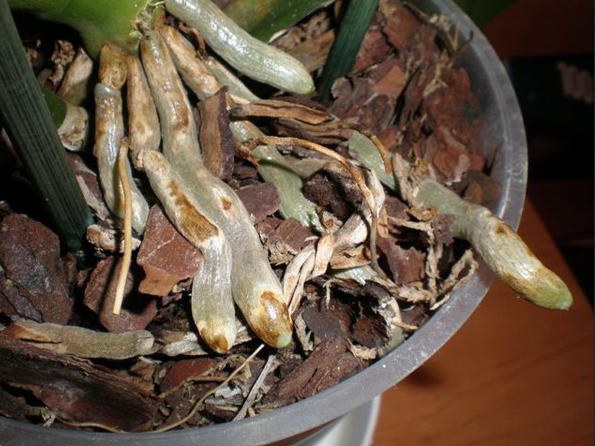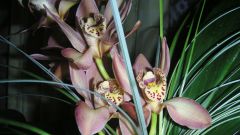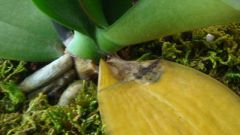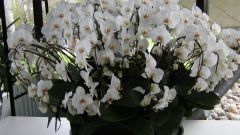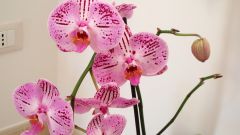You will need
- Orchid, activated carbon, charcoal, fungicides.
Instruction
1
Too wet content of the plants. The root system of orchids consists of three parts: the green root, covering the root velamen and the growing tip. Velamen performs such functions as suction, moisture, nutrients. It also protects the root from mechanical damage. Lovers of orchids often face such problems as rotting, drying the roots. The decay occurs mainly due to excessive and frequent irrigation, low temperature for a long time to dry out the substrate. Rot is not caught early, soon destroys the entire root. The reactivation of the plant without roots is very complex and is rarely luck.
2
Appearance root rot: brown or black color, when you click of them the water flows, the top layer is removed without effort. If you detect such signs, remove the roots without delay. Even if the root is healthy, but in some place there is a dead area, it must be cut off. This spine does not benefit the plant, but on the contrary, can infect stems. To trim the roots, take the scissors or sharp knife. Be sure to treat the instruments with alcohol, as there is always a risk to infect the roots of the fungus. Mash charcoal and sprinkle them with the cut. With the same purpose, you can use activated charcoal.
3
Fungal diseases of the root system. Fungi, often parasitic on the root system of orchids. The most common are soil fungi. In small concentrations they are not harmful. But once reduced solar illumination, the substrate is received very much moisture will create a favorable environment for the mass reproduction of fungi. Some need 6 hours to eat away at the root. After the defeat of the entire root system of the fungus enters the stem and leaves. The leaves appear brown and red-brown spots. And after the leaves have deposits dispute.
4
This disease is caused by fungi called Rhizoctonia, or brown rot. When it is found, remove the Orchid from the pot, carefully wash the roots in warm water, rotten places on the roots and leaves remove. Place cuts on the roots disinfect charcoal, and the leaves with iodine or green paint. Then dry the roots and soak in a fungicide. In the suppression of Rhizoctonia proven substances such as Tolclofosmethyl, or Pencycuron Boscalid. Even if the Orchid is not too affected, not to plant it directly into the substrate. Twice treated with fungicides because the fungus is very tenacious. Orchid could easily do without the substrate a couple of weeks or more.
5
White spider webs and soil fungi. The disease manifests itself in the form of a thick web, which is formed inside the substrate and on the surface. Often formed cotton balls similar to the balls. And if you dig up the substrate and sniff, you can smell the mycelium. Leaves, a stalk of orchids in this disease begin to turn yellow, get wrinkled and covered with black dry sections. Upon detection of this fungal disease, you must get the Orchid from the pot, rinse the roots with warm water and repot the flower in a non-infected substrate.
6
If the web has grown and has infected the roots, then soak them for 10-15 minutes in a weak solution of fungicide. If the solution of a fungicide is highly concentrated, it will burn tender plant roots. It is better to dilute the fungicide in distilled or filtered water. When working with mushrooms is always wash your hands thoroughly. Their waste products do not let children and Pets, as they can be poisonous. Pot rinse well using a disinfectant (even the toilet). New substrate for orchids should contain 20% peat and 15% charcoal. This is an unfavorable substance to the development of soil fungi. Transplanted the Orchid, avoid watering the next 5 days. Moist soil is an ideal environment for the emergence of soil fungi.
7
Frostbite roots. Frostbite can occur in recently watered plants, if you keep it at a low temperature. On leaves and roots appear wet and slimy areas, which often stands out of the water. For the emergence of such symptoms Orchid it takes 40 minutes to stay at a low temperature. Frostbite can arise from airing. If the cold air struck the whole plant, restoration it may not be: throw away the Orchid. If the spots appeared only on several sheets, carefully cut them to healthy green tissue. Place cut wood or activated carbon. The use of other drugs is not desirable.
Note
The fungicide must be specified if it fits to combat black rot, blackleg, and so on.
Useful advice
Some compounds of copper, such as Bordeaux liquid, are also suitable for treatment of the affected roots of the orchids. When working with the roots need to be careful not to burn them.
